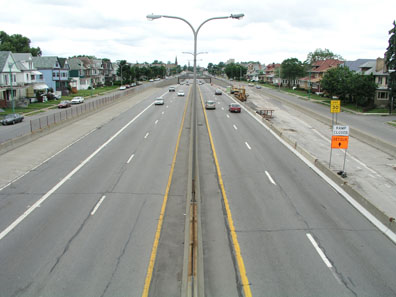 |
 |
 |
 |
 |
 |
||

Agaziz Circle to Martin Luther King Park.
You have to make this walk with two minds. One should be focused on what is in front of you with eyes of photorealism. The other must try to conjure what it can of what existed here prior to the 1960s.Gary Snyder says that you can only judge civilization by holding it up to wilderness. A corollary is that you can only judge current urban spaces and communities by those that preceded them. In this, Humbolt Parkway and the Kensington Expressway are a kind of litmus test of our city.
To begin this walk you need to park your car or bicycle in the parking lot in Delaware Park on Parkside near Humbolt. Then you have to contrive to get alive across the Sqaujaquada Expressway. Though there is a traffic light, there is no recognition of pedestrians here. Cars always have the right of way to be either moving ahead or turning into your path. You have to cross, because the north/east side of the Humbolt is no longer continuous, cut by the intersection of the Kensington and the Sqajauquada. You’d have to detour miles to close this 200 yard gap in the north/east band of the parkway. There is no parking allowed on the south side of Agaziz Circle. So we have our first two lessons in how communities are fragmented and split.
Now walking in relative safety eastward on Agaziz which becomes Humbolt we pass pleasant homes and see equally pleasant ones on the far side. At Main, the Kensington descends below ground level while Humbolt remains at ground level and Main passes over the Kensington on a bridge. There should be a marker saying that this is where was fought the first battle of Humbolt Parkway. The Kensington and Sqajauquada didn’t emerge piecemeal into public consciousness, though it was seen as a piece by the state planners. The first piece and the most strongly resisted was here. A lawyer named Robert Hithcock, who lived at 25 Woodward, headed a group that in 1949-50 opposed the construction of the “tunnel” on the basis that it and the proposed expressway through the park would take out 1500 trees, lower property values and break up the neighborhood. He claimed that the State threatened withdrawal of aid unless the tunnel was built. The Council voted 4 to 2 to oppose then tunnel. It got built. In 1954 the Buffalo News printed interviews with selected members of the opposition group who had changed their minds and now found the bridge beneficial. In a kind of pre-emptive attack it warned that any who might oppose the construction of the Kensington should consider this.
Apparently no one consulted the ghost of Frederick Law Olmstead who designed this Parkway to run between two of the larger parks he designed for the city, Delaware Park and the Parade Grounds, now Martin Luther King Park.